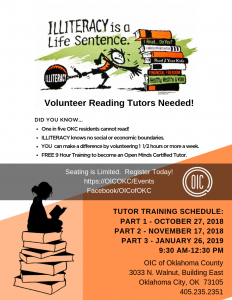How to Teach a Friend to Read
American Idol superstar Fantasia Barrino shocked the nation back in 2005 when she revealed that despite winning the popular singing competition, she was functionally illiterate. Unfortunately, Fantasia’s illiteracy isn’t that hard to believe. America is home to more than 30 million adults without the basic literacy skills to read a newspaper, understand medical documents, or fill out a job application. With such shocking statistics, chances are you know someone who’s functionally illiterate.
If you’re looking for ways to help, Blair Lanning, the Volunteer Coordinator at Opportunities Industrialization Center of Oklahoma County (OICofOKC), an Oklahoma City, OK, nonprofit that helps thousands of functionally illiterate adults each year, shared her top tips for helping your friends gain the literacy skills they need to be successful, thriving members of society.
1) Research local nonprofits. Blair says a good first step is searching out the existing service agencies or nonprofits in your community. Even at a time when nonprofits face diminishing budgets, they’re still out there willing to help community members. If you’re having trouble locating a local organization, make a phone call to a national organization like the National Coalition for Literacy. “A quick Google search will help you to find literacy organizations in your neighborhood” she says.
2) Visit your local library. Libraries might seem like the place to go after you learned how to read, but many local libraries offer free literacy classes, and if they don’t, “Your local librarian will have connections to the community organizations that do.”
3) Volunteer with OIC. Volunteering at a literacy organization might not be the massive time commitment you think it is. Blair says that at OIC, volunteers can sign up to attend a 8 hour training and then begin to schedule tutor sessions from there. Also, the kind of volunteering you do can vary depending on what skill sets you can bring. “Some OIC volunteers work one-on-one with students and meet up at local libraries, while other volunteers might serve in a class room as a personal tutor”.
4) Search Pinterest or YouTube. If you want to work with someone you already have a relationship with one-on-one, Blair says do a search on YouTube for ‘teaching adults to read.‘ “There are tons of ideas on there including lessons, techniques, and best practices that can get you started working with someone,” she says.
5) Motivate & be a Cheerleader. Blair says the average adult enters the program reading at about a second-grade level. “They’re embarrassed about it and they think they’re the only one that can’t read.” They already have low morale and talking about not being able to read might make them feel even more inadequate. Instead, Blair says to talk about “skill-building opportunities” instead of “reading classes”. “Learners respond better to that kind of language, and really, that’s what they’re doing, developing new skills.”
Sign up below for Free Volunteer Tutor Training Classes or visit us at oicokc.org or call Blair Lanning for more ideas on how to help (405) 235-2651

